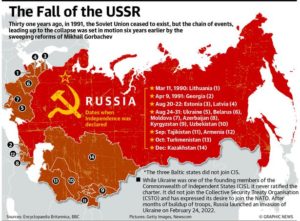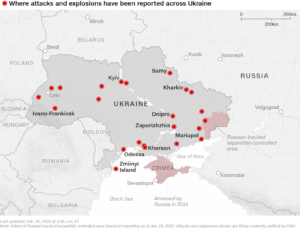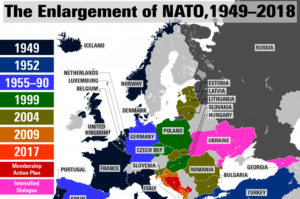ForumIAS announcing GS Foundation Program for UPSC CSE 2025-26 from 19 April. Click Here for more information.
Contents
- 1 Introduction
- 2 What has been the historic relationship between Russia and Ukraine?
- 3 How did Ukraine fall out with Russia?
- 4 How has the Russia-Ukraine Conflict unfolded so far?
- 5 What are the reasons behind Russian intervention?
- 6 How has the world reacted to the Russia-Ukraine Conflict?
- 7 What could be the probable impacts of the Russia-Ukraine Conflict?
- 8 What are the options before India regarding the Russia-Ukraine Conflict?
- 9 What is the rationale behind India’s stance?
- 10 What would be the impact of a prolonged Russia-Ukraine Conflict on India’s interest?
- 11 What lies ahead for India?
- 12 Conclusion
| For 7PM Editorial Archives click HERE → |
Introduction
On 24th February 2022 the Russian troops invaded the Ukrainian territory from three sides and the Russia-Ukraine conflict is getting intensified with every passing day. The Russian attack has sent shock waves across the world and created hardships for native Ukrainian citizens as well as the diaspora of foreign countries residing in Ukraine. The Western nations have imposed sanctions on Russia and have called for a UNSC meeting over the issue. But none of this has been able to deter Russia to soften its approach towards its intervention in Ukraine.
What has been the historic relationship between Russia and Ukraine?
A millennium ago, what is Ukraine today was part of the Kievan Rus’ (Rus’ land). It was a federation of the East Slavic, Baltic, and Finnic peoples of Eastern and Northern Europe, with its capital in Kyiv. Modern Ukraine, Russia, and Belarus all trace their cultural ancestry to the Kievan Rus’. After the decline of Keivan Rus’, the Ukrainian region was part of different empires and regions. Moving forward to the 19th century, the region was under the control of the Russian Tsar. This historical association had made the Russian President to note that ‘Russians and Ukrainians are one people divided artificially by borders and outsiders‘ in an an essay titled, ‘On the Historical Unity of Russians and Ukrainians’.
During the World War 1 (1917), the Bolshevik revolution took place in Russia that ended Tsar’s reign. Months after the revolution, an independent Ukrainian People’s Republic was proclaimed. However, a civil war continued between various claimants to power, including Ukrainian factions, anarchists, Tsarists, and Poland. Eventually in 1922, Ukraine (Ukraine SSR) became part of the Union of Soviet Socialist Republics (USSR).
In the late 1980s, as the internal conflict intensified in the USSR, over 300,000 Ukrainians created a human chain in support of freedom, and the so-called Granite Revolution of students sought to prevent the signing of a new agreement with the USSR in 1990. On August 24, 1991, after the failure of the coup to remove President Mikhail Gorbachev and restore the communists to power, the Parliament of Ukraine adopted the country’s Act of Independence. A referendum for independence held in December 1991 was supported by 92% of the people. In December 1991, the leaders of Belarus, Russia, and Ukraine formally dissolved the Soviet Union and formed the Commonwealth of Independent States (CIS).
Source: The Hindu
How did Ukraine fall out with Russia?
After its independent in 1991, Ukraine adopted a largely neutral foreign policy. It was one of the founding members of the CIS, but did not join the CSTO (Collective Security Treaty Organisation). Initially, Ukraine stayed away from NATO as well. But the offer of membership by the NATO in 2008 started changing equations between Moscow and Kyiv.
After the regime of pro-Russian Viktor Yanukovych was brought down in the 2014 Euromaidan protests and a pro-West government was established in Kyiv, the relationship turned hostile. Russia suspected hands of the Western Governments in engineering the regime change. Russia moved swiftly to take Crimea, which also hosts Russia’s Black Sea fleet, and started supporting separatist rebels in Donbas region in east Ukraine.
Ukraine later exited the CIS and wrote its desire to join NATO into its Constitution. These developments pulled the countries apart, setting the stage for permanent hostility, which led to the current conflict.
How has the Russia-Ukraine Conflict unfolded so far?
On 21st February 2022, the Russian President announced his decision to recognise the two breakaway regions of Ukraine (Donetsk and Luhansk) as independent states. On 24th February, Russia invaded Ukraine by land, air and sea. The main targets were military infrastructure. Russian forces pressed their advance on 25th February and the Ukrainian President pleaded with the international community to help the nation. A martial law has been imposed in Ukraine to effectively deal with the situation.
Source: The CNN
What are the reasons behind Russian intervention?
Security Concern: The influence of NATO has been expanding eastward in the European region since the Soviet collapse. The erstwhile USSR states like Estonia, Latvia etc. and the former Communist States in Soviet Sphere of influence like Romania have now joined the NATO.
There was a strong Russian apprehension that Ukraine was about to join NATO and that would have led to complete encirclement of Russia’s western border by the NATO. The NATO enlargement has been accompanied by deployment of Western military resources in the vicinity of Russia.
Source: The CNN
Right of Self Determination: Russia said Ukraine hosts a substantial portion of masses that want to create an independent nation. In this regard, it recognized Donetsk and Luhansk as independent states. The intervention is a step towards converting this formal announcement into reality.
Strategic considerations: Russia was constantly losing its glory and power in the European region to its western counterparts. Intervention is seen as a strong message to show the magnitude of power possessed by the nation.
How has the world reacted to the Russia-Ukraine Conflict?
G7 leaders on 24th February, promised ‘devastating packages of sanction’ on Russia. They however didn’t promise direct military intervention as Ukraine is not a NATO member. Nonetheless, they showed commitment to supply the necessary arms and ammunition to Ukraine.
The U.S, Britain, Germany and many other nations imposed harsh sanctions to cripple the Russian Economy. The sanctions would impede Russia’s ability to do business in major currencies and targeted individual banks and state-owned enterprises.
Similarly, a UNSC meeting was organized to condemn the Russian military action against Ukraine. The meeting was vetoed by Russia and hence the resolution couldn’t pass. However not all remaining 14 members voted in favor as 3 members (India, China and UAE) abstained from voting.
What could be the probable impacts of the Russia-Ukraine Conflict?
Loss of Human Lives: The most harmful impact would be loss of human lives from either side. No matter which nation emerges victorious in the conflict, a substantial number of people will certainly die.
Nuclear Risk: The Russian forces have taken control over the Chernobyl nuclear power plant. Their rampant activity may increase nuclear radiation levels around the region. Further Russia may use Nuclear Weapons if Western powers intervene in the matter, with the Russian nuclear deterrent forces already on high alert.
Militarization of Europe: An arms race could start again in Europe, with countries trying to raise their arsenal for protecting themselves against the sudden intervention from strong powers.
Global Economic Slowdown: The sanctions imposed on Russia may surge Global Prices of various commodities including oil. Trade would also be impacted. Stock markets have already plunged, and oil prices surged since the start of the conflict.
Undermining the Credibility of the UN: If the crisis doesn’t come to a halt in due time, then it would erode the UN’s credibility amongst smaller nations. It would further concretize the saying of might is right and undermine the concept of sovereign equality.
What are the options before India regarding the Russia-Ukraine Conflict?
There are four potential options India can choose from: (a) Condemn Russian aggression; (b) Support Russian aggression; (c) Stay silent on Russian aggression, or (d) Express displeasure (short of condemning) and call for diplomacy.
The first option will pit India against Russia, the second will pit it against the U.S. and its allies, the third option will be read as pro-Russia, and the fourth option — which it has taken — is the least harmful.
India has expressed displeasure but not outrightly condemned the intervention. India has called for an ‘immediate cessation of violence’ and has so far refused to pay heed to Ukrainian Ambassador’s pleas urging it to mediate with Mr. Putin to halt Russian military advances.
What is the rationale behind India’s stance?
Countering China’s Rise: Relying solely on the U.S and its allies is not enough to counter China’s aggressions. It needs both the U.S./the West and Russia to deal with the ‘China problem’.
Unavoidable dualism in Contemporary Indian strategic landscape: New Delhi needs Moscow’s assistance to manage its continental difficulties. These include ensuring defense supplies, helping India ‘return’ to Central Asia, working together at the Shanghai Cooperation Organization (SCO) or exploring opportunities for collaboration in Afghanistan. On the other hand, India is simply not in a position to address the China challenge in maritime space without the active support of American and Western navies.
Trade and Investment: India- Russia trade is valued at around $10 billion dollars. India imports a substantial amount of energy and defense material from Russia. Any extreme stance against Russia would have jeopardized the trade.
| Read More: India-Russia Trade Relationship Post Russia-Ukraine Crisis – Explained, pointwise |
What would be the impact of a prolonged Russia-Ukraine Conflict on India’s interest?
First, Russian action in Ukraine, dismissing the concerns of the rest of the international community, will embolden China and its territorial ambitions. China might adopt a more aggressive stance against Taiwan.
Second, the new sanctions regime may have implications for India’s defense cooperation with Moscow.
Third, the longer the standoff lasts, the closer China and Russia could become, which raises new challenges for Indian diplomacy.
Fourth, the more severe the US-Russia rivalry becomes, the less focus there would be on the Indo-Pacific and China, which is where India’s interests lie.
What lies ahead for India?
Going forward, India’s ability to be a ‘swing state’, ‘major power’ or a ‘leading power’ stands diminished. So India might adopt a more middle-of-the-road behavior rather than resolute positions on global strategic developments.
India should look for alternatives in place of Russia and reduce its high degree of dependence in sectors like defense and energy. For instance, in the case of coking coal, focus should be on Australia, Brazil and other central asian countries.
The countries should encourage diplomacy and dialogue between Russia and Ukraine based on mutually agreed terms. This is sine qua non for bringing long lasting peace in the region.
Until that is achieved, the focus should be on ensuring that Russia functions as per the Geneva Conventions on International Humanitarian Law.
Conclusion
The Russia-Ukraine Conflict is a litmus test for the International law which can be passed only when the major world powers are willing to dilute their rigid stance and cooperate on bringing everlasting peace in the region.








